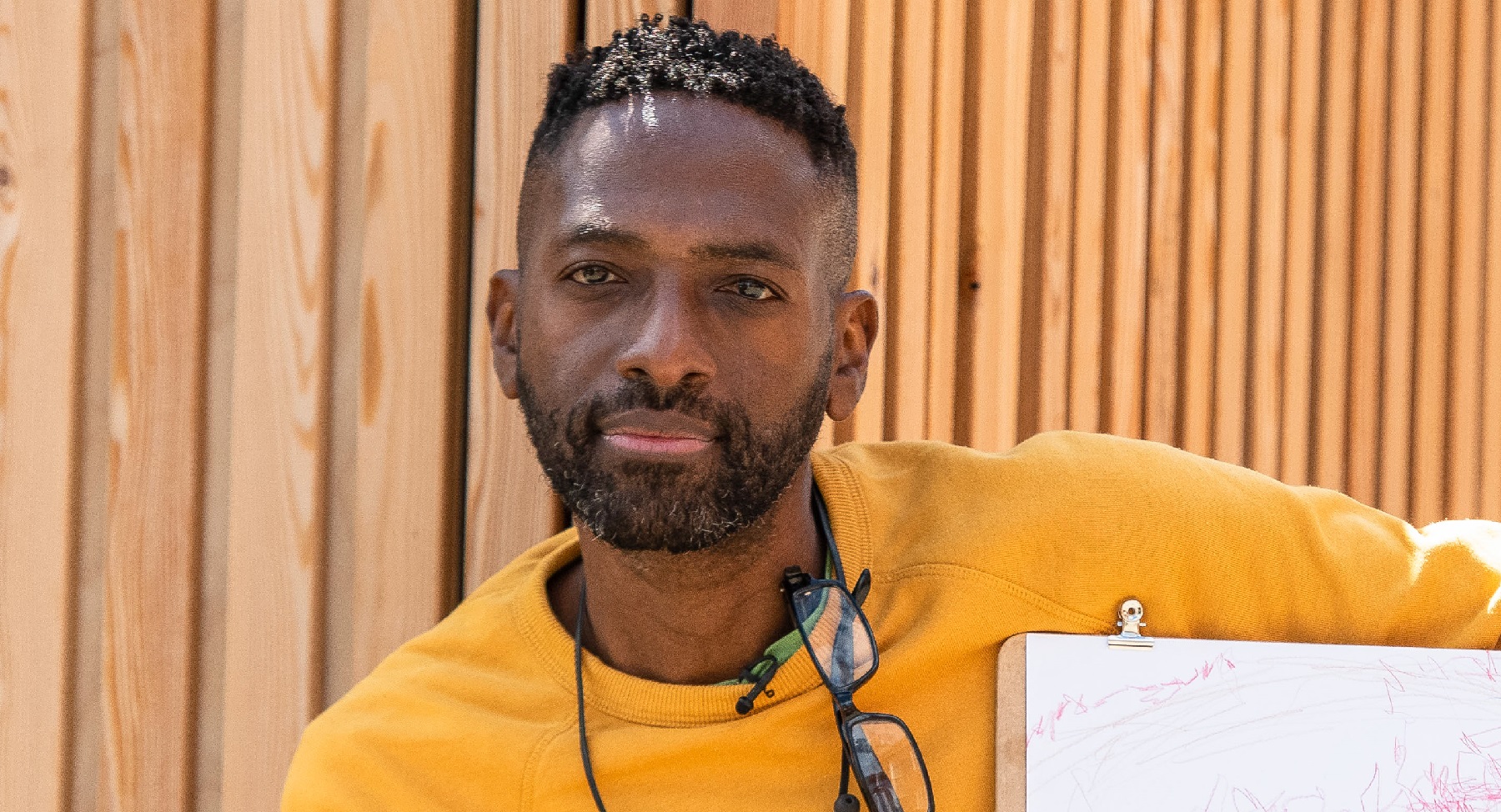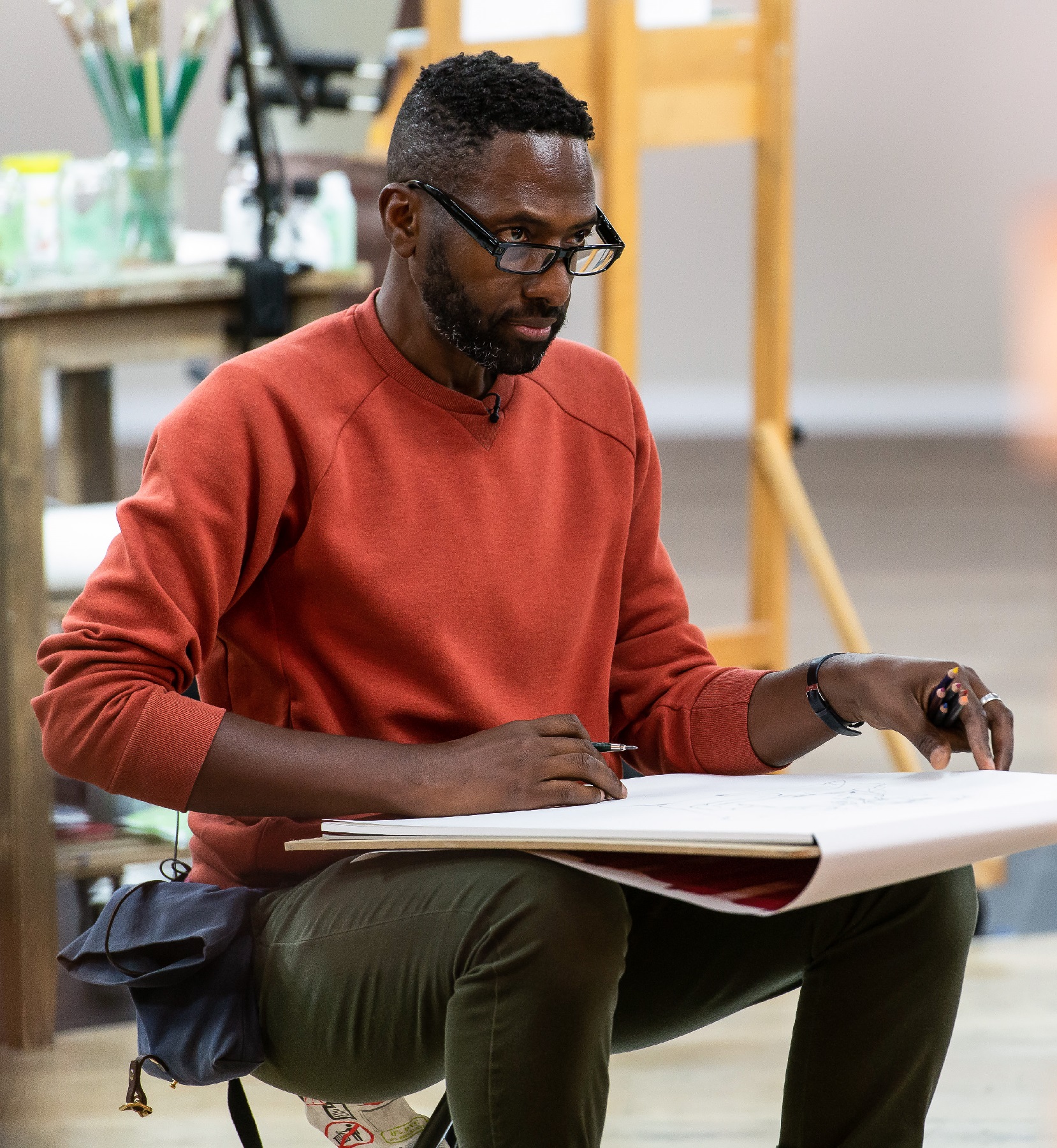Curtis Holder: From growing up gay on a Leicester estate to Portrait Artist of the Year
Exclusive: The winner of Sky Arts' Portrait Artist of the Year tells Attitude that growing up, art provided "an escape" to another world.
By Will Stroude

Words: Joseph Ryan-Hicks
From humble beginnings growing up on an estate in Leicester to becoming an award-winning portrait artist – Curtis Holder has achieved great things.
The 52-year-old, who currently resides in South London with his partner Steve, uses both graphite and colour pencil to “observe life, convey emotions and tell stories”.
Last year, Curtis found his craft put to the test when he competed against several other artists in Sky Arts’ Portrait Artist of the Year (which, spoiler alert, he won). The artists were tasked with creating portraits of the likes of Eddie Izzard, Normal People’s Paul Mescal and The Vivienne, to name but a few.
Curtis spoke with Attitude to discuss winning the prestigious competition, growing up as a Black gay kid in 1980s Leicester, and why he wants to inspire the next generation of young artists through education…

Curtis Holder drawing in the semi-finals of Sky Arts’ Portrait Artist of the Year
What did it mean to you to be recognised for your work, and eventually win, Portrait Artist of the Year?
Winning the competition meant so much. It has helped to validate my work and what I’ve been trying to do for many years. It now feels like pursuing life as an artist wasn’t a foolhardy mission. Hearing the judges critique my portraits and say that I have something special and unique to give was an amazing feeling. My friends and family have been saying it for years, but when it comes from total strangers whose job it is to judge you solely on the work, it means something different.
Describe your experience on the show. How did it feel to have your work judged with such high stakes?
Being on the show brought lots of different emotions. It was a joy to be chosen in the first place, but at the same time it was daunting seeing the work of all the other artists and being filmed for TV. I decided to take quite a pragmatic approach to the competition; I went in there planning to be true to myself and to have fun – if the judges liked my work then that was a bonus. Of course, it was still nerve-wracking anticipating how they would critique my portraits on national TV, but because I didn’t have any other expectations of myself other than being true to my process and my drawing, in some ways I had nothing lose.

Curtis’s portrait of his partner Steve and dog Freddie (Image: supplied)
Is there a piece that you are particularly proud of?
I’m proud of the portrait of my partner Steve and our dog Freddie that I produced as my commission for the finals of the competition. That portrait is an extension of who I am. It’s as much a portrait of myself as it is the subjects, because they are my family and the beings closest to my heart. Knowing someone can sometimes be a barrier to seeing the person with fresh eyes. To combat this, I thought carefully about the angle from which I drew Steve and Freddie, as well as the composition and the weight of the marks I made to create a piece of work that was sensitive and honest.
What role did art play in your life growing up in Leicester?
From a young age, art was always an important part of my identity; it provided a language to express myself in a world which at times didn’t make much sense. As the only Black family the neighbourhood and the only gay person I knew of, drawing was my escape into a world where I had some control. My mum was a nurse who understood anatomy and she was also a good draughtsperson. Although we didn’t visit museums and galleries, she would use the language of mark making to bring her world to life for me, whether it was the plant life of the West Indies, people she knew from back home or even architecture. At school I was known as the one who could draw, and that recognition helped my self-confidence and my ability to think independently. It also gave me the courage to be open about my sexuality at a young age.

Curtis and Eddie Izzard and the winning portrait from the finals of Portrait Artist of the Year
When did you decide to pursue art as a career?
In school, I gravitated towards friends whose lives were surrounded by art and several of my close friends had parents who were artists. I had no idea of how I would get from being a teenager from an estate in Leicester who was good at drawing to having a career that paid the bills. It was seeing an EastEnders character called Colin, a graphic designer played by Michael Cashman, that opened the door. Colin was gay, had a flat in London, a boyfriend and a drawing table. All of that seemed very appealing, so I applied for a Graphic Design degree in London, got an unconditional offer.
What has been your experience as an LGBTQ person in your field?
I thought being in the arts would be the gay equivalent of the land of milk and honey. To be honest when I was starting in the early ’90s, I didn’t meet any other Black designers or many other LGBTQ people working in graphic design, so at times that felt alienating. In recent years, that’s changed for the better. There are still inequalities, but it feels like the tide is turning. In terms of creating work, technology and social media have opened up a diverse new world where artists can connect with like-minded people whose ideas resonate emotionally and visually and that’s very powerful.

Curtis with his portrait of The Vivienne in the Portrait Artist of the Year heats
You have previously said that you are inspired by the world around you. How have the last 12 months impacted what you are creating? Is there a noticeable difference?
It’s been really difficult. As someone who draws people from life, not being able to have that physical proximity with sitters has meant I’ve been unable to observe them in the way I normally would. You miss the nuances of body language and unconscious movement which is important to the way I make marks and tell stories. I’ve needed to find new ways of making connections, mainly by drawing sitters online. When people are faced with a screen, they tend to mask their imperfections and give the best version of themselves which can be sometimes be two dimensional. I often find those perceived imperfections as the most beautiful aspects of their physical and emotional selves.
You teach primary education part-time – which is incredible! What spurred the decision to take this path and why do you think the arts are important in education?
I decided to become a primary teacher at a time when I was searching for a career that would be more emotionally fulfilling for me than being a graphic designer. Being in a classroom with 30 young minds is a job like no other and I definitely want to continue to be involved in education as I develop my career as an artist. All children are creative beings so teaching through the arts helps to make any concept easier to grasp and understand. It’s also an important way of reaching students who might otherwise struggle to engage in learning for whatever reason, as well as a tool for sharing and experiencing different cultures.

Curtis holding a self-portrait
The arts have taken a massive hit this past year. The Government’s ‘Rethink, Reskill, Reboot campaign being a disappointing reminder that the industry is often overlooked or disregarded altogether. Why do you think now, more than ever, we need to promote creative career paths for young people in the industry?
It’s difficult to put why people need the arts in a box, yet the recent pandemic has proven that we all need creative outlets for entertainment, our mental health and to escape the 9 to 5. Young people today are facing global challenges that require creative thinking and creative solutions whatever their field of work. I feel it’s hugely important that young people are encouraged and supported to follow their passions, explore new ideas and that they are given the freedom to try and test a broad a range of possibilities.
For anybody inspired by you and your work, what advice would you give to somebody picking up a pencil for the first time?
Whatever medium you’d like to explore I’d say do it as often as you can and don’t be too hard on yourself. You will probably be your own harshest critic, so be brave, be kind to yourself, enjoy your successes and learn from the process.
You can see Curtis’ work on his website curtisholder.co.uk or follow him @curtisartist on Instagram. Sky Arts Portrait Artist of the Year is available to re-watch on the Sky Go app.
